近年,在臺灣的表演藝術展演作品中,常可以見到「沉浸式」、「參與式劇場」、「移動式」、「觀眾參與」、「互動」、「非典型劇場空間」、「環境劇場」等概念的字詞交錯使用於節目文宣上。內容、形式與風格可能各異,閱讀起來頗令人眼花繚亂,好像無法只使用一個固定名稱去括弧出這類型的作品。總的來說,以上這些字詞指向的作品特性,已不是以往將觀眾固定在劇場座位席上、單向地接收舞台上的一切,這樣的觀演關係。它搖身一變,轉變成以觀眾作為中心、視角、感應、啟動與推進器。
換句話說,演出不再以表演者、故事、動作、情節為主,這並不表示它們不再重要,而是以觀眾置身在舞台的中心,強調個體觀眾的感知體驗,甚至是獨一無二、不可複製的經驗。「我」的身體感如何與空間周遭連結,成為展演設計的核心。
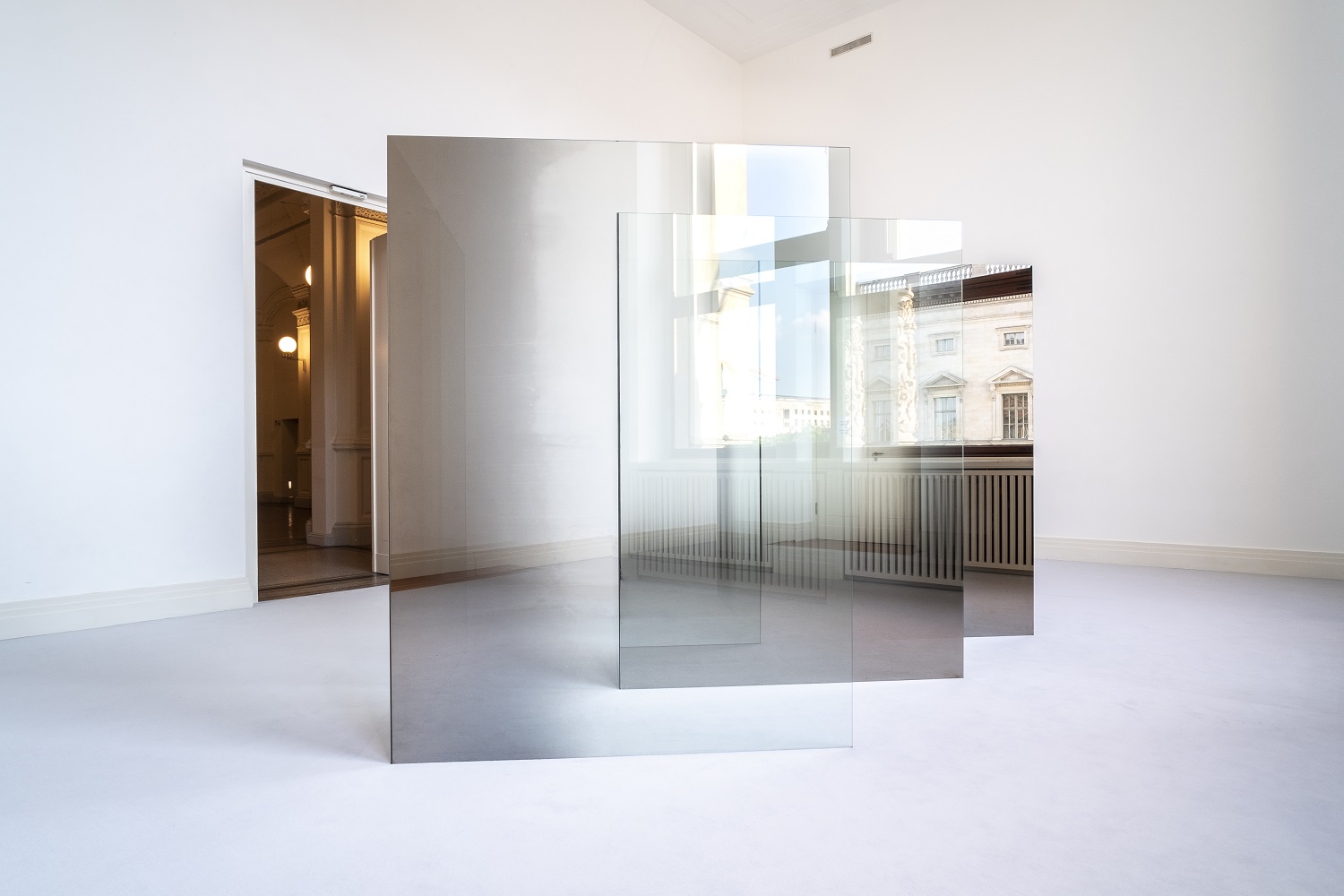 藝術家Larry Bell的作品《6 x 8: An Improvisation》(6 x 8: An Improvisation, 1994)於德國柏林的馬丁–格羅皮烏斯美術館(Martin-Gropius-Bau)舉辦的展覽「無外之境 1960年代至今的沉浸式空間」中展出。(Credit: Welt ohne Außen. Immersive Spaces since the 1960s. Photo by Mathias Voelzke)圖/Martin-Gropius-Bau提供
藝術家Larry Bell的作品《6 x 8: An Improvisation》(6 x 8: An Improvisation, 1994)於德國柏林的馬丁–格羅皮烏斯美術館(Martin-Gropius-Bau)舉辦的展覽「無外之境 1960年代至今的沉浸式空間」中展出。(Credit: Welt ohne Außen. Immersive Spaces since the 1960s. Photo by Mathias Voelzke)圖/Martin-Gropius-Bau提供
去年6月至8月德國柏林的馬丁–格羅皮烏斯美術館(Martin-Gropius-Bau)舉辦的展覽「無外之境 1960年代至今的沉浸式空間」(Welt ohne Außen. Immersive Spaces since the 1960s),就嘗試以裝置、表演、工作坊等多面向匯集整理,以美術館為基地來展示1960年代至今與沉浸式「空間」有關的藝術作品。1由科技藝術領域出發,強調觀眾在空間中參與的英國藝術團體「蘭登國際」(Random International,2005-),2012年創作的沉浸式互動裝置《雨屋》(Rain Room),2也在2015年首次於亞洲上海的余德耀美術館展出。成立於2010年的臺灣科技藝術創作團隊「涅所開發」(NAXS Corp.,Network Afterlife eXistence Storage),其結合VR裝置的無演員沉浸式空間劇場《Render Ghost》,在2015年拿到了「第六屆數位藝術表演獎」首獎,3並於2018年4月於國美館展覽「定製真實:數位藝術之魅」展演新的版本,運用科技藝術處理人過渡在虛實空間的感知經驗。4
上述的討論稍稍把視角拉遠,從美術館策展、空間、科技藝術裝置、VR虛擬實境結合劇場性空間運用來看沉浸式概念,範圍似乎可以再往外延伸得相當寬廣……。以下討論會將範圍限縮到表演藝術的沉浸式劇場,究竟怎麼樣的作品可以稱為沉浸式劇場?

以沉浸式劇場(immersive theatre)演出形式打響名號的先驅者,為2000年成立的英國劇場公司Punchdrunk。創立者菲利克斯.巴瑞特(Felix Barrett)在2011年把紐約的一棟倉庫改建為麥基特里克飯店(The McKittrick Hotel),做為特定場域的表演空間演出《Sleep No More》,開演後大受喜愛,直至今日仍持續上演。《Sleep No More》改編自莎士比亞的《馬克白》劇本,紐約版本其實是以2003年倫敦版與2009年波士頓版為基礎逐漸擴充,觀眾戴上面具於整棟大樓自由遊走,進場後演出會重複三次,在第三次加上結局。五層樓的空間探索與多達20位演員角色的移動跟隨,形式類似漫步劇場(promenade theatre),每一位參與者以自己經歷的時間路徑來體驗故事,創造了新的觀看體驗。Punchdrunk也於2016年在亞洲上海打造了《Sleep No More》新的演出據點。巴瑞特認為沉浸式劇場吸引當代觀眾的原因是「觀眾想感覺自己是真實的活著,在特定情況下可以自己決定,做出實際(physical)的選擇與行動,脫離數位世界與網路介面便利快速、充斥不真實的虛擬情境。」5
從史蒂芬.艾克特(Stephen M. Eckert)於2017年底一篇討論〈什麼是沉浸式劇場?〉的文章中,可以約略抓出西方對於沉浸式劇場概念的幾個關鍵要素:它重視實體空間設計、注意空間與環境上的設計細節、著重從觀眾視角出發的舞台設計、講求特定場域(倉庫、醫院、酒吧)、注重觀眾在空間中的感官/聲光體驗、容納任何可能的觀演互動形式、強調演出的時間歷程(duration)、使用多線敘事或空間遊歷、追求親密的及個人的觀演經驗,甚至可以是一對一的觀演形式。6
我們可以用較為簡潔的敘述來解釋:沉浸式劇場是以觀眾為表演的中心,由觀眾處在特定空間中展開實際體驗為主要展演形式。這的確與傳統在劇院固定坐位看表演的方式非常不同。在臺灣所發展的沉浸式劇場,是否有別於/或超出西方對於沉浸式劇場的表現手法?
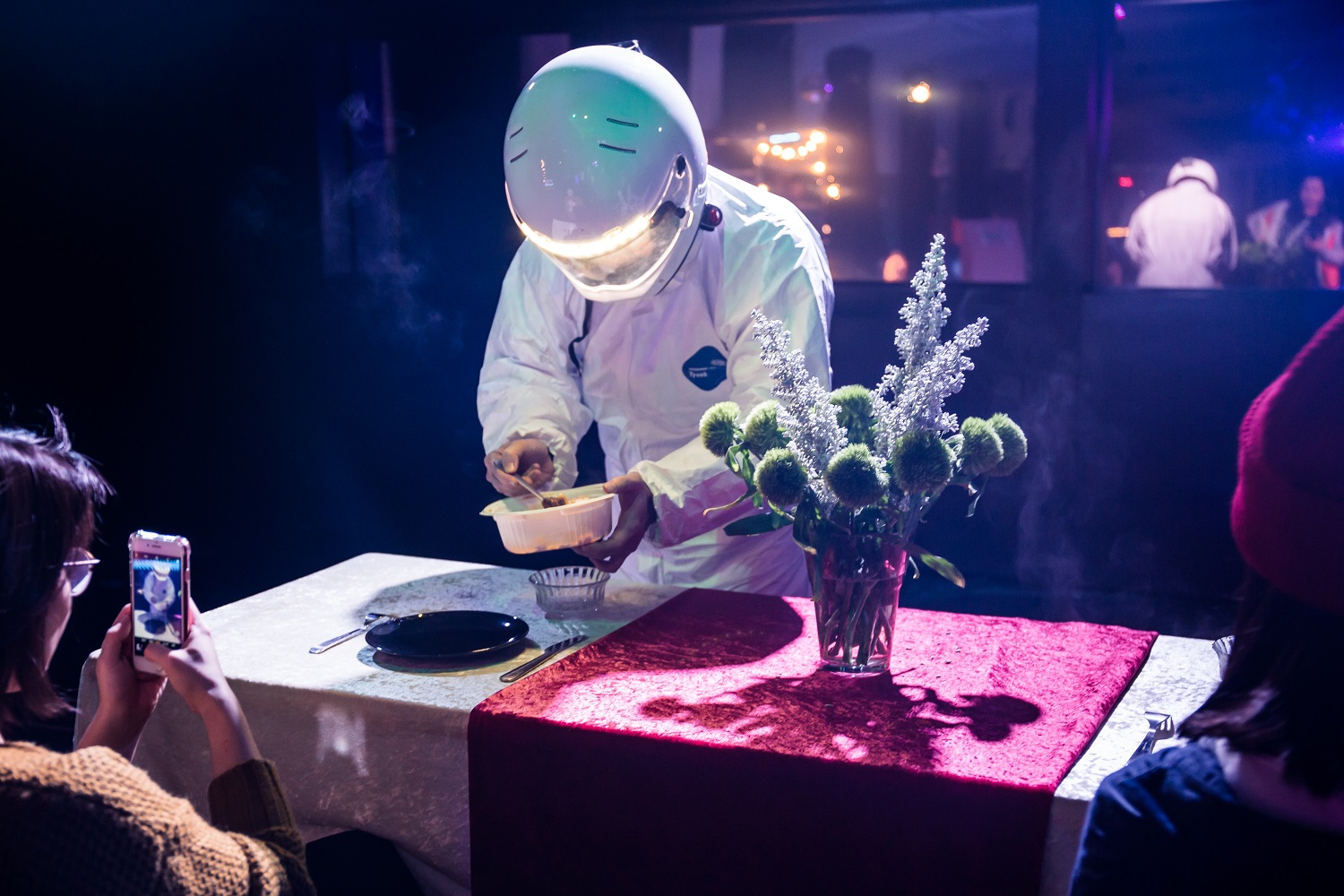 《人類派對》。圖/王政中攝影、進港浪製作提供
《人類派對》。圖/王政中攝影、進港浪製作提供
回到臺灣對於沉浸式劇場的相關討論,2017年貧窮男的〈兩個有關沉浸式劇場的演出〉展演評論,討論了兩個分別是劇場與舞蹈的作品,明日和合製作所 (Co-coism)《尚未指稱的對話》與林文中舞團《掽,碰!》,值得一提的是前者在演出設計上加入了密室逃脫與投票制度,關於後者,貧窮男則提及沉浸式結合舞蹈的難處是「觀眾缺乏與舞者互動的經驗與基礎」,7他也在文章中提到沉浸式劇場在臺灣的「變形」觀察。
貧窮男另一篇關於進港浪製作《人類派對》的展演評論中,提到這是個乍看會讓觀眾誤以為是沉浸式劇場的圈套,8雖然在一開始《人類派對》的節目單中,並沒有特別強調它是什麼類型的作品,只強調「空間」與「規則」。9張敦智則從創作者選擇的主題與空間裝置給予展演結構性的批評,因為它同時連動了觀眾在空間中如何行動與自我反饋。10導演洪唯堯認為作品中「觀看與被觀看,是《人類派對》很重要的一件事。」11他所設計的兩個展演空間「展區」與「動物園」,同時讓觀眾置身處地的「體驗」到兩種觀看的差異。在後續《PAR表演藝術》雜誌以「參與式」為名的專題企劃中,可以看到《人類派對》、《遙感城市》和《Sleep No More》三者以「參與式」角度作為討論基礎,洪唯堯在最後提到「我覺得《人類派對》沒那麼『參與式』,但參與式藝術的『感覺』就是重點。」12回顧以上關於作品的討論,雖然說參與式劇場(participatory theatre)一樣重視觀眾體驗,《人類派對》實則更接近沉浸式劇場展演方法。
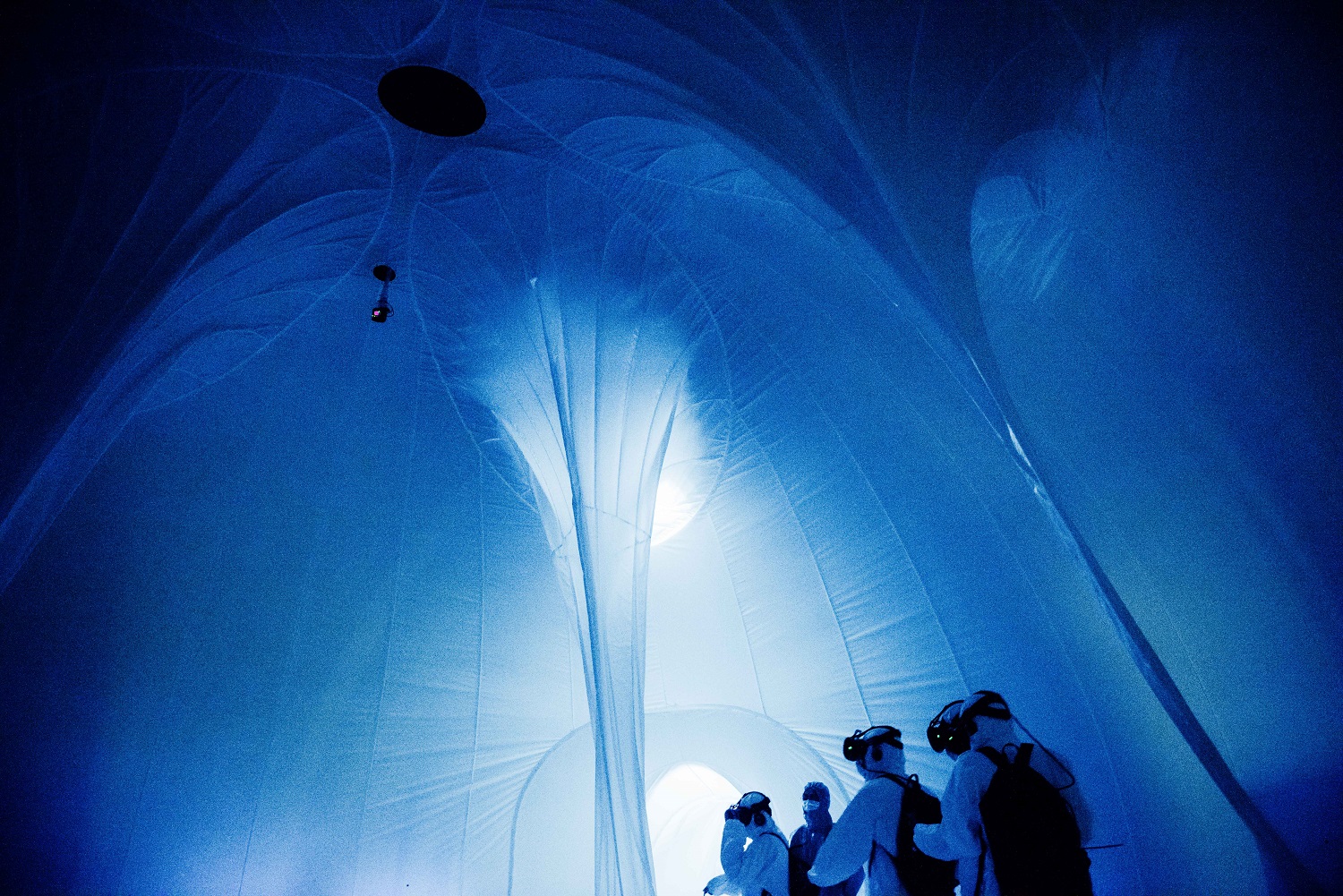 涅所開發的作品《Render Ghost》強調觀眾的體驗。圖/陳藝堂攝影、涅所開發NAXS Corp提供
涅所開發的作品《Render Ghost》強調觀眾的體驗。圖/陳藝堂攝影、涅所開發NAXS Corp提供
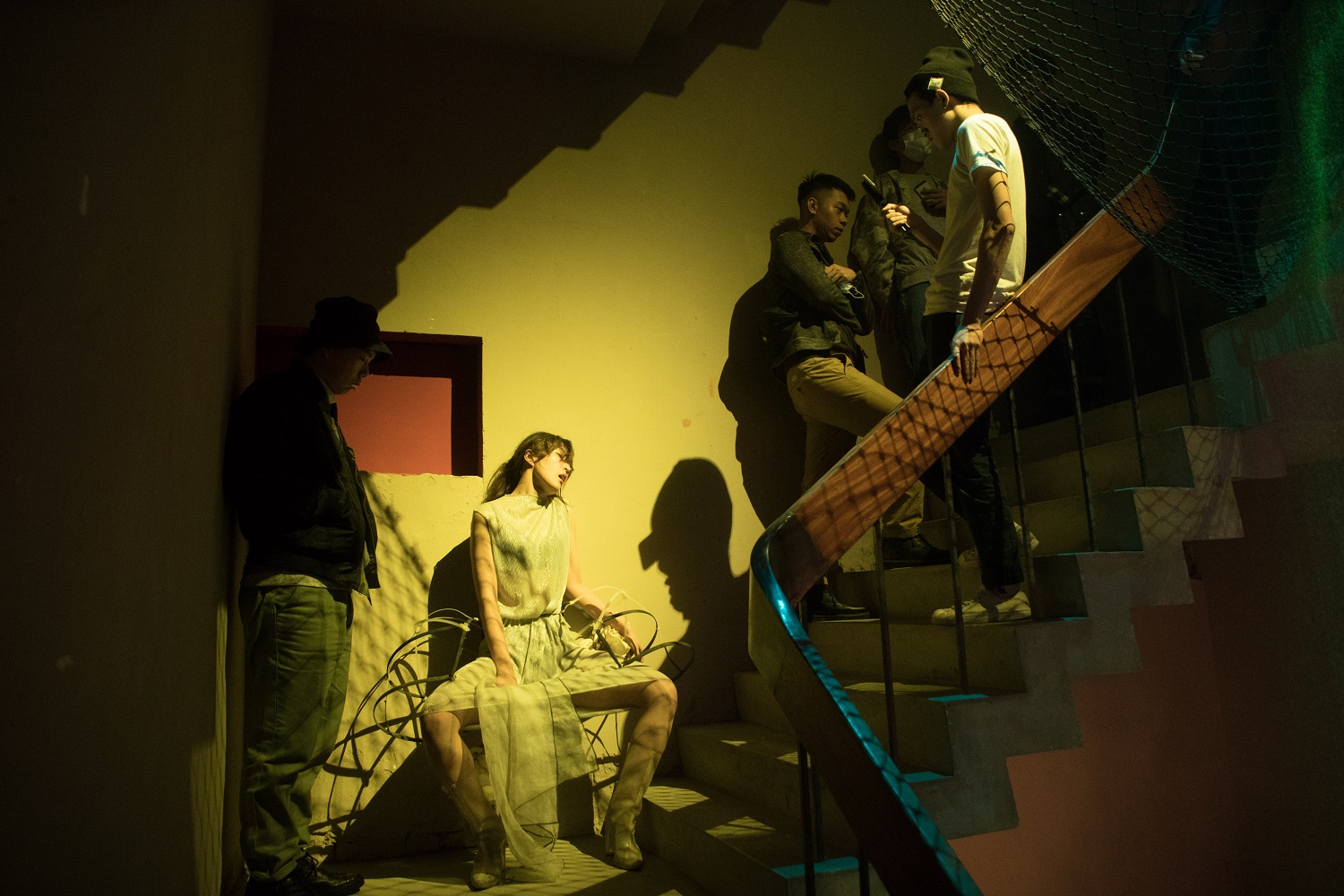 明日和合製作所的作品《恥的子彈》。圖/李欣哲攝影、明日和合製作所 co-coism提供
明日和合製作所的作品《恥的子彈》。圖/李欣哲攝影、明日和合製作所 co-coism提供
回顧2018年觸及沉浸式展演討論的相關文章。樊香君在〈被愛撫的並不是被觸摸的〉一文中,不從「沉浸式」、「體驗式」的空間與設計談起,而是從法國哲學家伊曼紐爾.列維納斯(Emmanuel Lévinas)「被愛撫(caressed)的並不是被觸摸的」的個人身體的觸覺感知角度切入,以「刺激感官」、「擬真感官」、「擾動感官」分別討論以下三件作品:明日和合製作所在澳門的《坐坐茶室》、涅所開發《Render Ghost》、葉名樺《一個人的美術館――寂靜敲門》,詰問這類強調「感官」與「體驗」的作品究竟要說什麼?她認為比起感官感覺,能否「感知」更顯重要。13
順著上文多次提到的「體驗」,也可以從王柏偉〈體驗(experience, Erleben)〉一文中得到他對當代與視覺藝術領域中以「體驗」作為關鍵字的解讀法,除了區分體驗與經驗,他也以尼克拉斯.魯曼(Niklas Luhmann)的理論將「行動/體驗」作為歸因用圖式(schema),將體驗式藝術區分為:將「體驗」視為「行動」(不一定是觀眾參與式的)與從「『體驗/行動』作為圖式」出發,前者舉的例子是張永達的「相對感度」系列、陶亞倫的《留白》,與一當代舞團蘇文琪《從無止境回首》;後者則回到表演藝術領域(也較貼近本文從沉浸式劇場角度談及的範圍),探查「『體驗/行動』作為圖式」如何誘發觀眾參與到「事件」經驗中,並以明日和合製作所《走路去月亮的人》、《請翻開次頁繼續作答》為例。他觀察到除了明日和合製作所,再拒劇團、進港浪製作、風格涉也在此類型中持續嘗試著。14
汪俊彥則是透過對於明日和合製作所《恥的子彈》的評論,談〈沉浸式場域中的表演與觀眾角色變遷〉,他認為觀眾本來就具有兩種身分:作為現實社會的我與劇場中的觀眾。因而,沉浸式表演在空間上更加強了觀眾行動的能動性,不過,他也認為《恥的子彈》「佈建了每個人都以相當弔詭與矛盾的『被鼓勵』主動性,既『自由、多元又開放』的參與。」15此外,他也在文章中提到沉浸式演出被商業與消費市場吸收、接納的觀察,「包含密室脫逃、競賽遊戲、尋寶等等娛樂式的遊戲者,都注意到了這些非典型劇團的節目;以沉浸式劇場為名的演出,擴大了劇場的傳統參與觀眾。」16
正面切入談沉浸式劇場理論,可見於香港藝評人鄧正健寫於今年3月號澳門《劇場閱讀》的〈總體身心經驗的(不)可譯性――沉浸式劇場理論初探〉一文,從文本翻譯、文化轉譯的角度談起,區別了環境劇場(environmental theatre)與沉浸式演出的差異,環境劇場是「透過改變空間來完成劇場」;沉浸式劇場則是「直接把臨摹過程銘刻在參加者的身體上」。他認為應從傳統劇場指稱的「觀眾」(audience)改為沉浸式劇場的「參加者」(participator)――沉浸式劇場在命名上已預設須以參加者的身心經驗為劇場主體。不論是談及情動理論(Affect Theory)或是科技技術/裝置的介入(也與我們對科技的依戀有關),沉浸式劇場的創作者其實擁有絕對強力的場面調度與對結構的嚴密控制,如何因地制宜、因人而異地去貼近參加者,而不是只讓參加者成為規則操作下的「劇場生化人」,是鄧正健認為沉浸式劇場作為方法,創作者需思量著墨的。17
而香港藝評人肥力則對卡塔琳.特蓮雀妮(Katalin Trencsenyi)《戲劇顧問:連結理論與創作的實作手冊》書中提到的劇場從過往國家主導或是以人民生活為主的,兩種建立劇場的目標感興趣。其中對於劇場屬於人民的觀點,連結到觀眾為主體的沉浸式劇場在當代日益茁壯發展,著實是劇場導向人民(觀眾)偏移的表徵。就這個導向人民觀點來看,肥力也對鄧正健一文中使用「沉浸式劇場」作為中文翻譯提出批評,認為應該改為「體驗劇場」,此外,他也藉由他在英國幾個月時間中參與眾多「體驗劇場」表演形式的經驗,認為「『Immersive』與『Theatre』的維度,已是異常地廣闊及模糊,它甚至只是一場街頭的表演,一次餐聚、或隨導遊(表演者)遊覽,不論是體驗或是劇場,其實可說已被濫用及泛指不同層面的行為上。」最後他回歸藝術評論本位,談及在以人民(民眾)體驗為主的時代,當我們去討論何者是藝術何者不是藝術時,當我們去討論作品是否具有美學/藝術價值或僅只是消費行為時,才是真正進行判斷與評價的開始。18
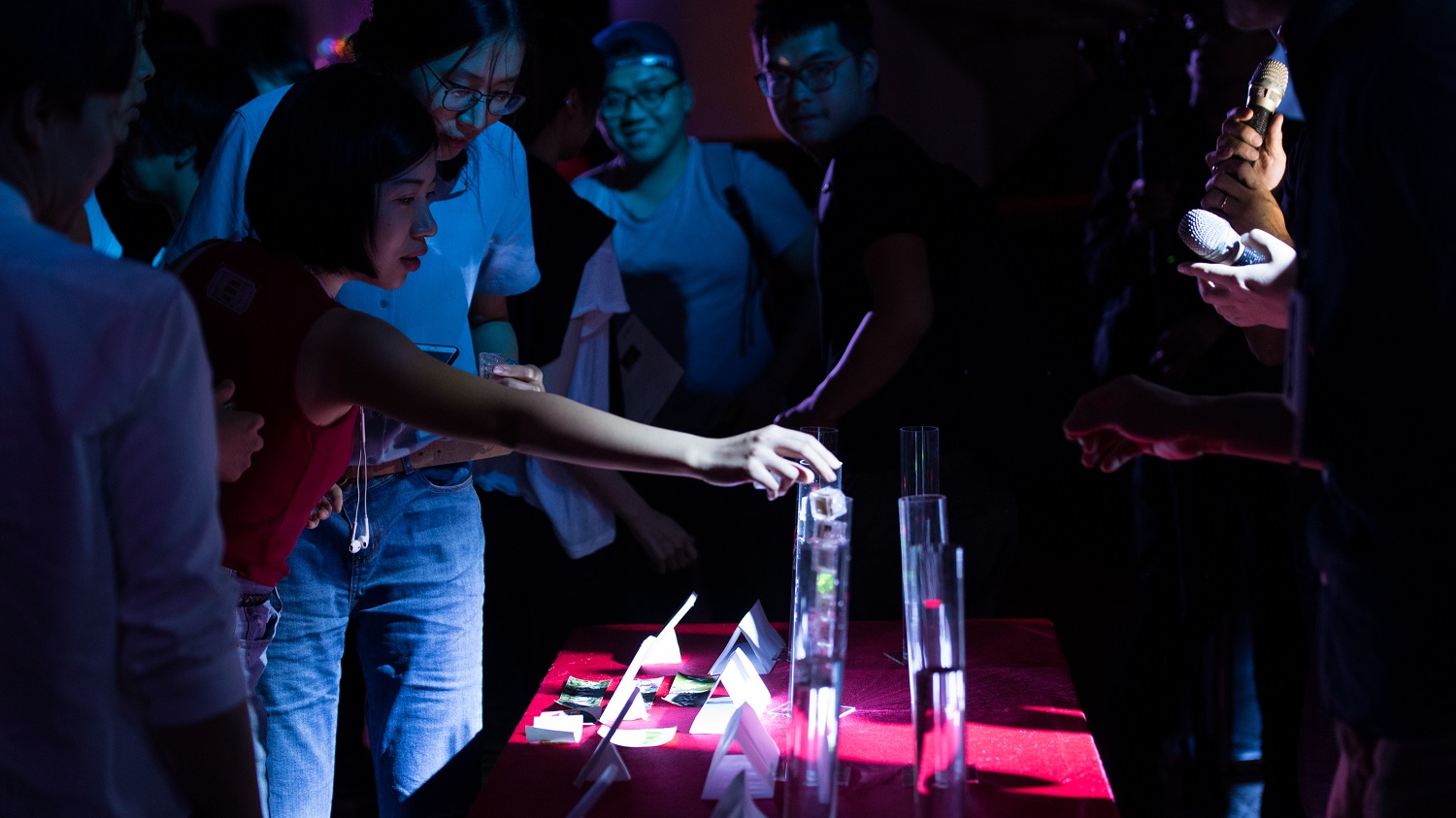 明日和合製作所的作品《山高流水之空中》在2018臺北藝術節演出。圖/羅慕昕攝影、明日和合製作所 co-coism提供
明日和合製作所的作品《山高流水之空中》在2018臺北藝術節演出。圖/羅慕昕攝影、明日和合製作所 co-coism提供
接下來,將以《山高流水之空中》、《夜長夢多:異境重返之求生計畫》、《過站不下的心理時間》三個2018年作品為例子討論其展演方法。
《山高流水之空中》為2018年8月臺北藝術節的參與式展演,19展演地點在臺北市中山堂光復廳。展演議題與特定地點的歷史、政治特殊性扣連在一起,邀請參與者進行提問、投票,形成一場在真實歷史空間進行的虛構民主議會活動。弔詭的是《山高流水之空中》不管是在空間上還是參與上的設計,20劇場所動員的能量都無法超越固有的政治現實(比如臺灣的新聞媒體),在議題表現上能量相對弱勢,甚至戲謔好玩的成分居多。以沉浸式劇場來看的話,的確不會讓參與者相信與主動浸入,反而是與整場演出一直保持一定的內在心理距離,與作品的距離感從頭到尾都沒有消除過。
值得關注的是,在前文被多次提及的、2016年由黃鼎云、洪千涵、張剛華成立的明日和合製作所,在此類型領域的實驗創作投入甚多,是相當活躍的團體。他們內部採取不分上下階層式的共作模式(包含各自與外部創作者的合作),都為其創作打開了有別於一般劇場工作模式的觀看視野。對比於《山高流水之空中》,2019年臺北藝術節的《家庭浪漫》(雖然它並不是沉浸式劇場)以個人情感建構劇場參與,的確較能以假(展演)喚真(情感),而少了參與者去質問作品(劇場)與現實(社會)的校準與差距問題。21
 黑眼睛跨劇團演出《夜長夢多:異境重返之求生計畫》的劇照。圖/陳藝堂攝影、黑眼睛跨劇團提供
黑眼睛跨劇團演出《夜長夢多:異境重返之求生計畫》的劇照。圖/陳藝堂攝影、黑眼睛跨劇團提供
另一個展演議題與特定地點高度相關的沉浸式劇場,為2018年12月黑眼睛跨劇團的《夜長夢多:異境重返之求生計畫》,22其以白色恐怖景美紀念園區仁愛樓讓參與者體驗置身在日治時期、二二八與白色恐怖時期的浸身切膚感受。劇場創作者共有三位,分別是周翊誠、陳彥斌、譚鈺樵,VR部分則由楊乃甄的VR團隊製作。
演出的路線規劃以整棟建築物為移動範圍,幽暗的園區建築,一切顯得不太清晰可見。同時,空間的可怖感來自於特定場域的真實歷史――臺灣警備總司令部軍法處看守所,尤其在過程中參與者有多段被蒙住雙眼,僅能透過自己的腳步、被工作人員親密觸碰與引導動作、手觸摸牆面的觸感對空間產生感知,也由於當下視覺無法準確記憶空間,不真實的朦朧空間記憶與身體觸碰成了在空間中身不由己的被限制體驗,也轉換到受難者議題與參與者的身體記憶,且留下不少對建築內外部空間的空白記憶。
蒙眼時的身體狀態、摸黑行走的廊道、耳機聲音的聆聽、角色扮演、走道上的舞蹈、VR影片,《夜長夢多:異境重返之求生計畫》的設計,讓參與者在一整棟大樓中體驗被監禁、看不清、失去方向感、被拷問的種種不自由。
演出過程以多段各式不同的體驗方式與手法組成,雖有多樣空間的遊歷感,演出設計對歷史創傷的召喚與重現,也在一定程度引起身體感知的共感,不過這麼多的表演形式都放在同一個作品裡,對於參與者形成整體作品的認知,亦帶來某種程度的干擾與不統一,尤其是VR房間的VR影片,更使參與者的感受大幅度地抽離原本的演出空間與現場。
《過站不下的心理時間》為2018年11月在桃園鐵玫瑰藝術節的節目,由「黃/瑞/漢」團體(黃郁晴、周瑞祥、李國漢)所做,演出標榜為「全球首齣在機場捷運列車呈現的沉浸式戲劇演出」。23這個作品可以說融合了環境劇場的實地實境空間,特別的是它非懷舊非歷史非特定建物,而是以當代大眾交通運輸系統為背景坐標,更因為交通運輸營業時間的不停運轉、停歇、再啟動的永恆移動性,猶如當代生活重複疲憊不堪的縮影。
參與者搭配耳機與導覽人員指引,使這場演出有著如里米尼紀錄劇團(Rimini Protokoll)在兩屆臺北藝術節《遙感城市》(2017、2018)的沉浸式聲音效果,不過,《過站不下的心理時間》特別的是,透過心理測驗填寫與導覽人員的引導與提問,使參與者在個人心境的內部反思上、耳機聲音浸潤的內在引導上,與外在空間在生理與心理上不斷地相互切換感官知覺。尤其外在的真實環境中又有許多擦身而過的過客與在這真實背景下出現的演員表演,加上魔術的巧妙設計,交錯疊加了當下的身體在這三者間不斷相互虛實穿越的身體感知。這趟旅程,從戴上耳機,從北車步行到機場捷運,搭上車,沿途城市風景,就在抵達第二航廈站時戛然而止。何謂旅途?劇場是一趟真實旅程或是象徵人生旅途?《過站不下的心理時間》以行進中的移動使觀眾以參與展演的身分重返日常,形成了非常強烈的身體體驗與日常生活的劇場化效果。24
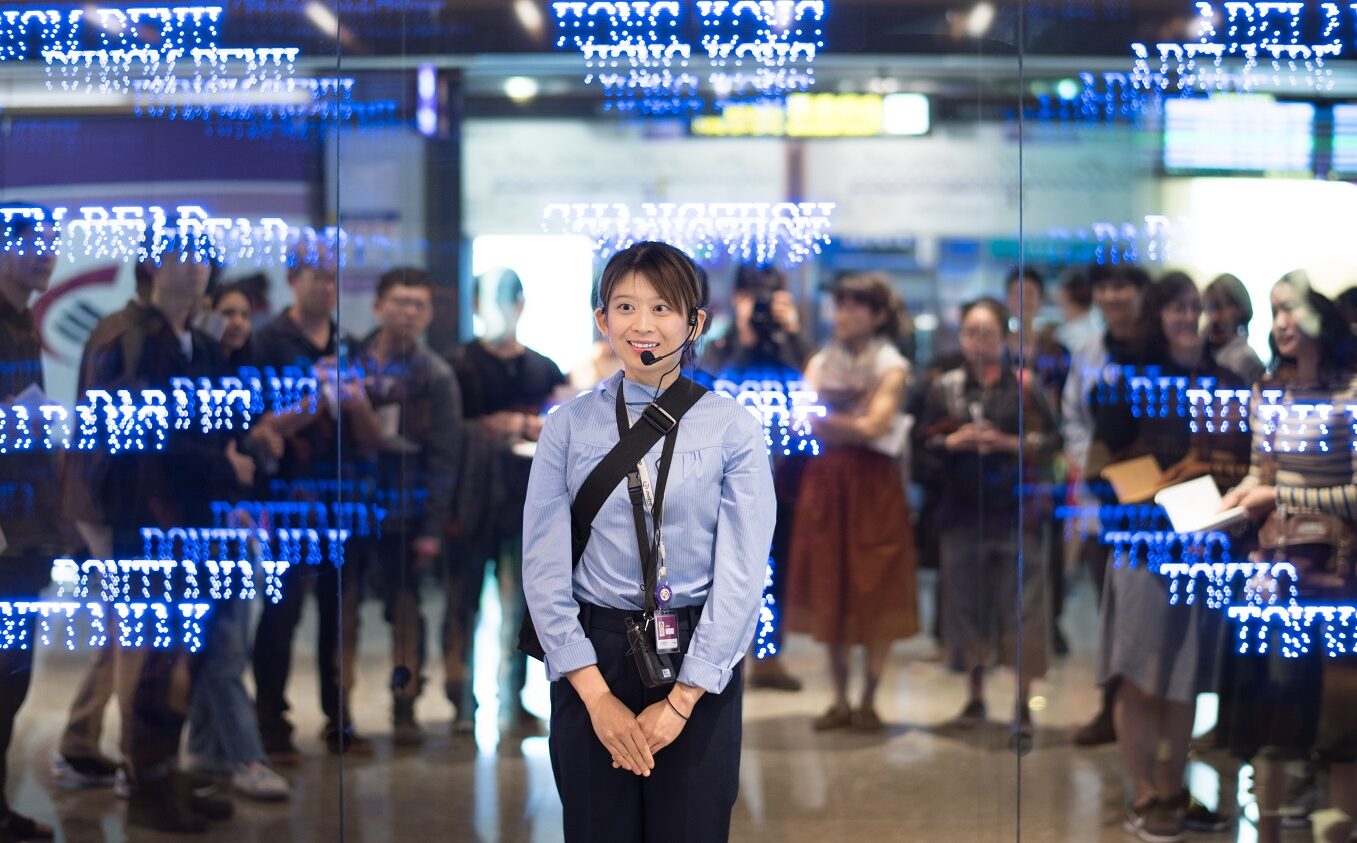 《過站不下的心理時間》,演出接近尾聲,在A13機場第二航廈站出口,圖為演員鍾婕安。圖/牧童攝影、黃郁晴提供
《過站不下的心理時間》,演出接近尾聲,在A13機場第二航廈站出口,圖為演員鍾婕安。圖/牧童攝影、黃郁晴提供
 《遙感城市》劇照。圖/臺北表演藝術中心提供
《遙感城市》劇照。圖/臺北表演藝術中心提供
由此比較,臺灣創作的沉浸式劇場較不以完整的文本為主幹,如《Sleep No More》所打造的完整故事情境空間,而是強調與特定空間、特定議題、特定環境的使用做結合,從參與、互動或是強調反饋的參與體驗切入,或許也是礙於臺灣目前的劇場演出場次與裝搭臺週期生態,要創作縝密的、達到觀眾作為中心的沉浸式整體空間與舞臺設計,現實上可能不容易。反過來說,也許是目前臺灣的沉浸式劇場往環境劇場、漫步劇場、聲音浸潤、結合VR裝置等,應著固有生態所長出的創作方向。
以上,從當代沉浸式現象觀察、西方「沉浸式劇場」定義與舉例、展演評論回顧整理(時間範圍限縮在2018年前後)、個人展演觀察與分析,試圖找出沉浸式劇場在臺灣發展的特殊性。我們也可看到臺灣目前對於沉浸式的討論方式,不論是使用的字詞(參與式、沉浸式、體驗、感知……)或是錯落在藝術不同領域(電影、視覺藝術、數位藝術、表演藝術),都呈現相互混雜、跨域的狀態,也尚處於發展中的階段。唯一可以確定不變的是,沉浸式劇場將會持續圍繞觀眾/參與者的體驗為首要核心。
而本文最終的目的不是、也暫時無法去定義臺灣的沉浸式劇場,更不是要把作品強制分類。筆者個人觀看經驗也形成上述討論案例的限制,為了限縮討論範圍,僅以年度框限並列舉三個展演作品為例。本篇嘗試的是以「沉浸式美學」為切入角度,來審視臺灣沉浸式劇場目前的評論與創作發展狀況,留下文字紀錄,待未來書寫者與創作者持續投入。